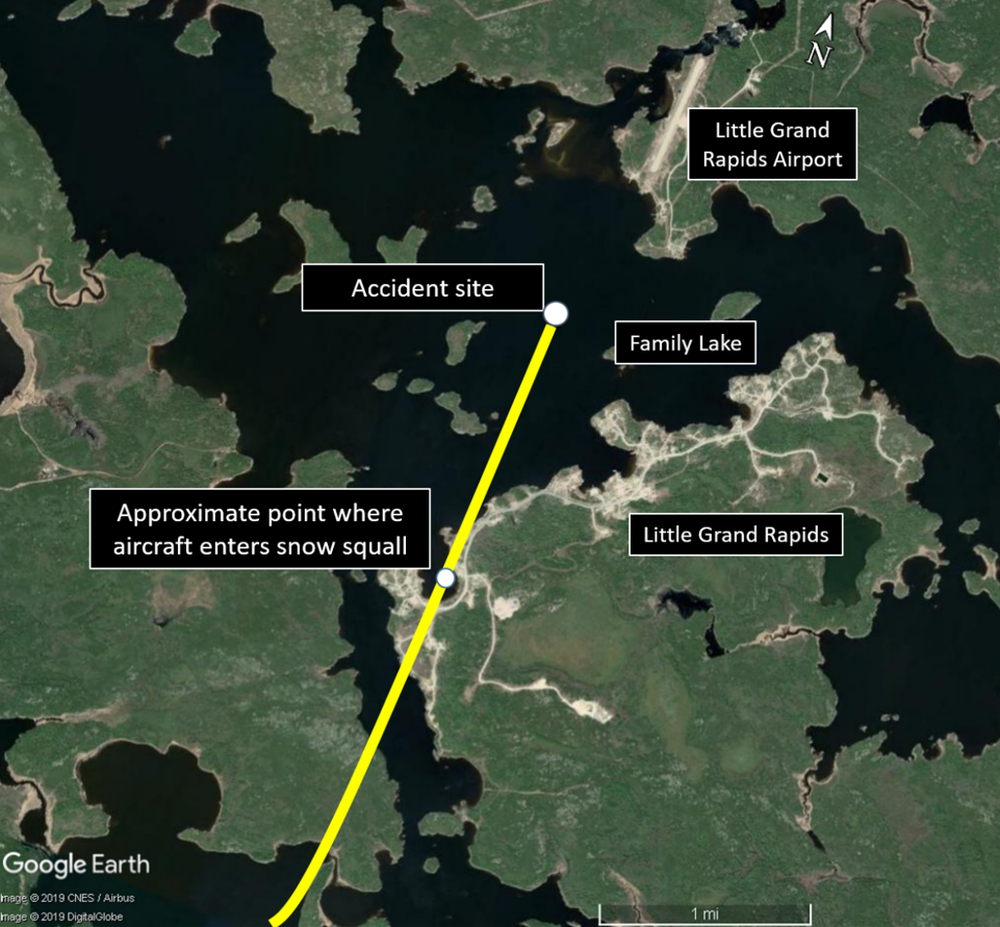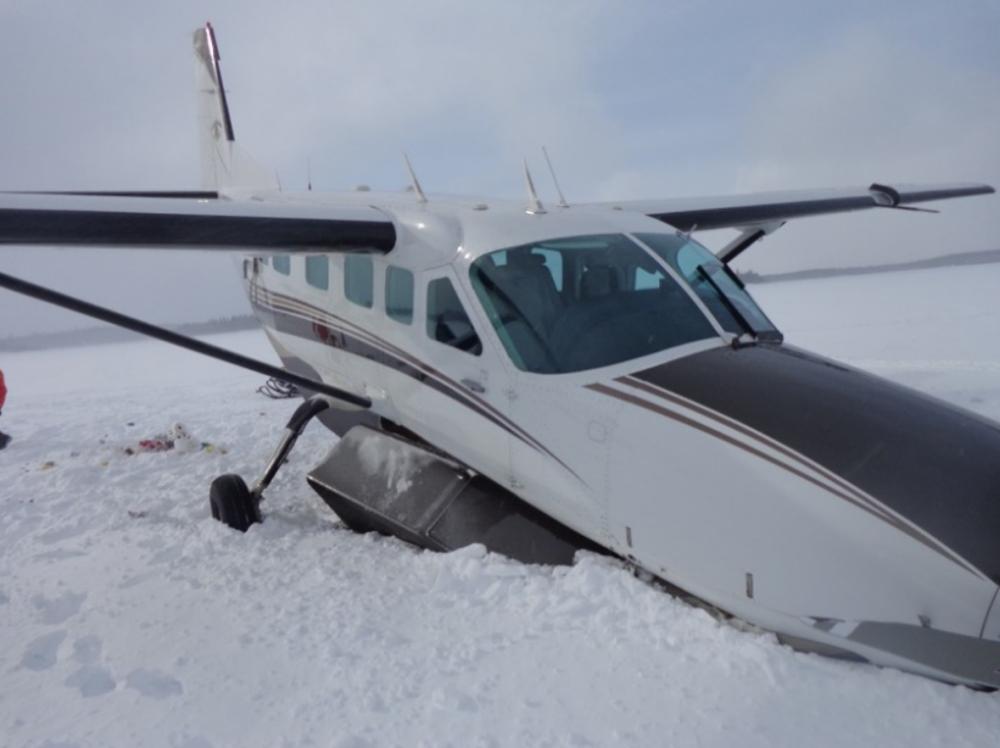Controlled flight into terrain
Amik Aviation Ltd.
Cessna 208B Caravan, C-FAFV
Little Grand Rapids Airport, Manitoba, 0.75 nm S
The Transportation Safety Board of Canada (TSB) investigated this occurrence for the purpose of advancing transportation safety. It is not the function of the Board to assign fault or determine civil or criminal liability. This report is not created for use in the context of legal, disciplinary or other proceedings. See Ownership and use of content. Masculine pronouns and position titles may be used to signify all genders to comply with the Canadian Transportation Accident Investigation and Safety Board Act (S.C. 1989, c. 3).
History of the flight
At 1315Footnote 1 on 04 March 2019, the Amik Aviation Ltd. (Amik) Cessna 208B Caravan aircraft (registration C-FAFV, serial number 208B0528), departed Winnipeg/St. Andrews Airport (CYAV), Manitoba, for a visual flight rules (VFR) flight to Little Grand Rapids Airport (CZGR), Manitoba, with 1 pilot and 6 passengers on board.
Throughout the 133 nautical mile (nm) flight, the aircraft encountered a number of snow squalls, which reduced the flight visibility to approximately 3 nm. The pilot elected to continue the flight through these areas of snow squallsFootnote 2. In the areas not affected by snow squalls, the weather was reported to be good visibility and clear skies.
As the aircraft approached CZGR from the south, the pilot had the airport environment in sight and manoeuvred the aircraft to join a 3 nm final approach and descent for Runway 36. When the aircraft was approximately 1.75 nm from the threshold of Runway 36, it encountered another snow squall, which reduced the flight visibility to less than 1 nm. The aircraft continued the descent in reduced visibility over the snow-covered frozen surface of Family Lake.
At approximately 1414, the pilot made the decision to initiate a go-around; however, as power was being applied, the aircraft collided with the frozen surface of Family Lake, 0.75 nm from the threshold of Runway 36 (Figure 1). The aircraft remained upright and slid to a stop on the snow. The pilot and 6 passengers received minor injuries and were able to egress from the aircraft. They were rescued by passersby on the nearby ice road. The aircraft was substantially damaged.
Weather information
According to the graphic area forecast (GFA) chart issued at 1131 on 04 March 2019 and valid at the time of the occurrence, the weather in the area surrounding CZGR was forecast to be broken layers of clouds between 6000 and 16 000 feet above sea level and visibility greater than 6 statute miles (sm). The forecast also called for patchy areas of visibility between 4 sm and greater than 6 sm in light snow with ceilings at 1500 feet above ground level (AGL) and localized areas with visibility of 2 sm in light snow.
CZGR does not have a surface weather reporting station. The nearest station is Berens River Airport (CYBV), Manitoba, located 62 nm west-northwest of CZGR. At 1400, the reported weather at CYBV was:
- wind 330° true at 13 knots, gusting to 22 knots
- visibility 1 sm in light snow and blowing snow
- ceilings of broken clouds at 500 feet AGL and 1500 feet AGL
- temperature of −12 °C, dew point of −16 °C
Following the accident, the TSB requested that Environment and Climate Change Canada complete a meteorological assessment. The assessment's concluding remarks indicated the following:
Surface observations from around the region show that visibilities were reduced briefly to 1 to 2 statute miles in heavier bands of snow. It is possible the aircraft encountered these heavier bands of snow during its descent. There was no turbulence or icing forecast over the area of concern.Footnote 3
Pilot information
Records indicate that the pilot was certified and qualified for the VFR flight in accordance with existing regulations. He held an airline transport pilot licence and a valid Category 1 medical certificate. The pilot had accumulated over 12 000 hours total flying time, with 1100 hours on the aircraft type. He held an instrument rating and had accumulated approximately 4000 hours of instrument flight. However, the validity of his instrument proficiency check had expired on 01 September 2017; therefore, he did not meet the recency requirements to exercise the privileges of the instrument rating.
Company information
Amik was founded in 2008. The company is approved by Transport Canada to operate under Subpart 703 of the Canadian Aviation Regulations. This approval is limited to day VFR operations only.
At the time of occurrence, Amik was operating 4 aircraft: a Cessna 208B, a Cessna 208, a Cessna A185F, and a de Havilland DHC-2.
Aircraft information
The Cessna 208B is a high-wing, fixed-gear aircraft equipped with a Pratt & Whitney Canada PT6A-114A turboprop engine. The aircraft type is equipped for day VFR operations, but can also be equipped for night and instrument flight rules (IFR) operations, and flights into known icing conditions.
The occurrence aircraft, manufactured in 1996, was equipped for night and IFR operations. It was also equipped with a cargo pod, and had been modified to increase the maximum allowable takeoff weight to 9062 pounds. Amik maintained the aircraft for day VFR operations only. The investigation determined that the aircraft's gross weight was approximately 8310 pounds on departure and that the centre of gravity was within the allowable limits.
The aircraft was not equipped with a flight data recorder or a cockpit voice recorder, nor was it required to by regulation. The aircraft was carrying a portable GPS (global positioning system) tracking device that uploaded position data at 5-minute intervals via satellite to an internet-based utility. This enabled the operator to monitor the aircraft's location. However, because of the sample rate of the device, it was not possible to reconstruct a flight profile for the investigation.
Records indicate that the aircraft was certified, equipped, and maintained in accordance with existing regulations and approved procedures.
The aircraft sustained damage to the fuselage, landing gear, propeller and engine (Figure 2). Damage to the propeller indicates that the engine was producing substantial power when the aircraft struck the snow-covered frozen surface of the lake. The floor at the front of the cabin had buckled due to forces transmitted from the nose landing gear drag brace. The engine mounts were slightly deformed.
Each seat was equipped with a lap belt and a single-strap shoulder harness. All of the seats remained attached to the cabin floor.
Visual flight rules flight into instrument meteorological conditions
The hazards associated with continuing a VFR flight into instrument meteorological conditions are well documented. According to data collected by the TSB between 2000 and 2014, accidents involving flights that depart under visual meteorological conditions and continue to a point where pilots lose visual reference with the ground have a high fatality rate. Over the 15-year period, these types of accidents resulted in 74 fatalities.
In addition, factors such as flight experience, instrument training, and aircraft equipment must be considered during pre-flight planning to mitigate in-flight hazards, such as encountering deteriorating weather conditions. Furthermore, lapses in decision making, maintaining situational awareness, and interpreting changing weather conditions may compromise the safety of a flight in challenging conditions and increase the likelihood of controlled flight into terrain (CFIT).Footnote 4
CFIT often occurs in low visibility, at night, or in poor weather. These conditions reduce the pilot's awareness of the surrounding area and make it difficult to visually determine the aircraft's proximity to terrain.
Winter weather and whiteout conditions
The accident occurred on a frozen lake that was completely covered in snow. There were few trees or other features to provide visual references. The terrain, coupled with the reported weather conditions, was conducive to whiteout. The Transport Canada Aeronautical Information Manual (TC AIM) provides the following information about whiteout:
Whiteout (also called milky weather) is defined in the Glossary of Meteorology (published by the American Meteorological Society) as:
“An atmospheric optical phenomenon of the polar regions in which the observer appears to be engulfed in a uniformly white glow. Neither shadows, horizon, nor clouds are discernible; sense of depth and orientation is lost; only very dark, nearby objects can be seen. Whiteout occurs over an unbroken snow cover and beneath a uniformly overcast sky, when with the aid of the snowblink effect, the light from the sky is about equal to that from the snow surface. Blowing snow may be an additional cause.”
[…]
Consequently, whenever a pilot encounters the whiteout conditions described above, or even a suspicion of them, the pilot should immediately climb if at low level, or level off and turn towards an area where sharp terrain features exist. The flight should not proceed unless the pilot is prepared and competent to traverse the whiteout area on instruments.
[…]
If at all possible, pilots should avoid such conditions unless they have the suitable instruments in the aircraft and are sufficiently experienced to use a low-speed and minima [sic] rate of descent technique to land the aircraft safely.Footnote 5
Flying in whiteout conditions may result in a poorly defined visual horizon that will affect the pilot's ability to judge and stabilize the aircraft's attitude, or reduce the pilot's ability to detect changes in altitude, airspeed, and position. In conditions where visual cues are sufficiently degraded, control of the aircraft or situational awareness may be lost, which could lead to a CFIT.
Safety message
Continued flight in deteriorating weather conditions, such as whiteout, can lead to disorientation and CFIT. All pilots—no matter how experienced they are—must be vigilant when encountering deteriorating weather conditions and be prepared to take the appropriate mitigating actions.
This report concludes the Transportation Safety Board of Canada's investigation into this occurrence. The Board authorized the release of this report on . It was officially released on .

